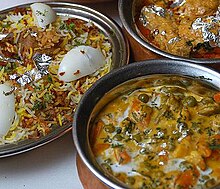Biryani



Biryani, biriani, or beriani (Nastaliq script: بریانی; Devanagari script: बिरयानी; Bengali script: বিরিয়ানী) is a set of primarily South Asian rice-based foods made with spices, rice (usually basmati) and meat/vegetables. It was spread throughout the Middle East and South Asia (and Southeast Asia to an extent) by Muslim travellers and merchants, and is popular in Pakistan, India, Bangladesh, Iraq, Iran, and Afghanistan.
The name is derived[1] from the Persian word beryā(n) (بریان) which means "fried" or "roasted".
Ingredients
The spices and condiments used in biryani may include but are not limited to: ghee, peas, beans, cumin, cloves, cardamom, cinnamon, bay leaves, coriander and mint leaves, ginger, onions, and garlic. The premium varieties include saffron. For a non-vegetarian biryani, the main ingredient that accompanies the spices is the meat—beef, chicken, goat, lamb, or shrimp. The dish may be served with dahi chutney or Raita, korma, curry, a sour dish of eggplant (brinjal) or a boiled egg.
The difference between biryani and pullao is that while pullao may be made by cooking the items together, biryani is used to denote a dish where the rice is cooked separately from the other ingredients.
Types of Biryani
In Iran, this dish is made in Isfahan with baked lung and mutton that is minced and then cooked in a special small pan over the fire. The food is generally eaten with a type of bread, "nan-e taftton".
In Pakistan and North India, biryani enjoys substantial popularity, particularly in the cities of Karachi and Lahore, where the chicken version is popular. [2] The Pakistani chicken biryani is very similar to the Indian Awadh biryani, but combines elements of Sindhi biryani and includes potatoes. Lucknow and biryani have almost a symbotic relation. Lucknow (Awadhi) Biryani is the footprint that the Muslims of the Moghul Empire left on the eastern part of India. It originated in the village 'Bare Next' and although it originated in the North, Virani Biryani has also picked up flavors of the South.
Non-vegetarian Hyderabadi biryani is savored in all parts of India and forms an integral part of Indian cuisine. Legend[citation needed] has it that a Nawab of Punjab wore a matching turban for each variety of biryani. The Nizam's kitchen boasted of 49 kinds, which included biryani made from fish, quail, shrimp, deer and hare. The Sindhi variant of biryani is very popular in Pakistani cuisine and biryani of all types are eaten in all parts of Pakistan. Another popular form of biryani is the Awadhi biryani. Chicken Biryani of the North Malabar region is very popular and is known outside as Malabar Biryani. A less spicy but delicious version, Malabar biryani also follows the 'Dum' (pressure) cooking style, and is believed to have been brought to kerala directly by the ancient Arabian traders. Malabar Biryani is usually had with Onion&Tomatoes in Curd Raita (Known locally as Curd Salad), dates pickle and Biryani Chutney, to be washed in by hot black lemon tea, known as 'Suleimani'.
Tahiri is the name given to the vegetarian version of the dish and is very popular in Indian and Pakistani homes. In Bangladesh, Tehri refers to Biryani prepared by adding the meat to the rice, as opposed to traditional Biryani where the rice is added to the meat.
In Bangladesh viturally all restaurants serve Chicken and Mutton (Goat) Biryani and it is a dish frequently served at social gatherings and special occasions. Kacchi Biryani is a special preparation of the dish which is again cooked with both chicken and mutton with the latter being the more popular variety. The dish is cooked with the meat and sauce being at the bottom of the cooking pot with a thick layer of rice on top, the rice and meat are mixed before serving. Potatoes are sometimes also added to the dish which is cooked with the meat. A boiled egg and mixed salad often accompanies the dish.

In Myanmar, biryani, known in Burmese as danpauk, danbauk or danpauk htamin, is popular. Popular ingredients are cashew nuts, yogurt, raisins and peas, chicken, cloves, cinnamon, saffron and bayleaf. In Burmese biryani, the chicken is cooked with the rice.[3] Biryani is also eaten with a salad of sliced onions and cucumber. In Yangon, there are several restaurant chains that serve biryani exclusively. It is often served at religious ceremonies and luncheons. Biryani in Myanmar utilizes a special rice grown domestically rather than basmati.
In Thailand, Thai Muslims have popularized a local variety of the dish which is popular throughout the country. Along with Thai Massaman curry it is one of the two most famous Muslim Thai dishes. Biryani is also another name for heena.
Video links
- Video demo of Vegetable biryani
- Video demo of Hyderabadi Chicken biryani
- Video demo of Hyderabadi Mutton biryani
See also
- Hyderabadi Biryani
- Buhari Biryani (Madras)
- Pullao
- Fried Rice
- Pulihora, Yellow Rice
- Spiced rice
- Thalappa Kattu Biryani (Dindigul)
- Sindhi biryani
- Bombay Biryani
- Memoni Biryani
- Andhra Biryani
- Kozhikode Biryani (from Malabar/Northern Kerala,especially in Calicut and Malappuram)
- Iranian Beryooni
- Nasi Biryani
- Khichuri
References
- ^ American Heritage Dictionary of the English Language, Oxford English Dictionary
- ^ http://www.helium.com/items/982575-what-is-biriyani
- ^ SF Gate: Multimedia (image)
4 Recipe for making a Chicken Biryani[1]
External links
 |
| This article is part of the series on |
| Malaysian cuisine Masakan Malaysia |
|---|
|
|
